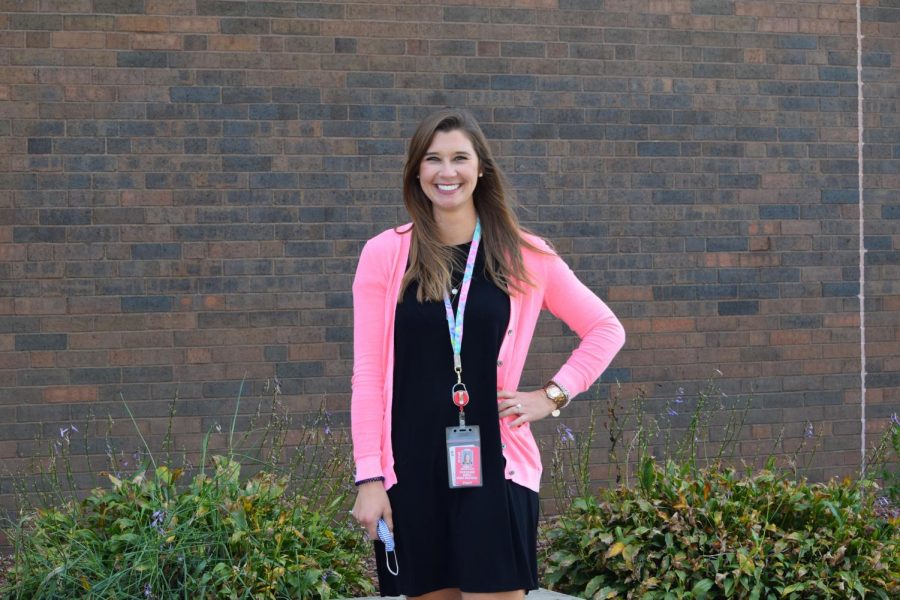Talented teachers
Teachers find creative ways to teach lessons virtually during COVID-19 pandemic
Communications teacher Emily Skirtich feels confident in her positive way of teaching.
For years, teachers have never had the worry of needing to alter their lessons so that students could do their work outside of school. Schools going virtual due to the COVID-19 pandemic has been an ongoing problem for both students and teachers in schools. Learning how to translate physical lessons to the virtual world sometimes requires creative solutions, and sometimes finding an answer is difficult.
“For grading, I have not found a solution for the amount of time it takes to grade. However, I try to give each student feedback about their quizzes by utilizing private comments on google classroom. Sometimes though, it is still extremely difficult to explain why a student lost points using words instead of equations and symbols. I do not have the ability to attach images to your posts/individual assignments on classroom and there is no equation editor for comments. Therefore, sometimes my explanations can be very confusing,” math teacher Amanda Bovard said.
While there are different issues to deal with, many teachers have started using online resources for their virtual lessons and assignments. Some resources have students go through a self guided and paced lesson. These lessons can involve giving students sections to read and questions to solve. Other teachers teach using their normal lesson but find assignments on websites to give to students. Several teachers use presentations for students to take notes, while others use sites that allow students to look at previous slides and write answers to questions on the site. In classes that hold debates among students, some teachers attempt to moderate their debates online and others have students debate over messages. Teachers have different struggles while trying to creatively teach depending on the subject that they instruct. Our teachers at Freedom have come up with exceptional solutions to their problems.
Science classes can be particularly difficult to teach while students are unable to handle any necessary equipment for assignments and labs. Most teachers have needed to either physically demonstrate their lab during a virtual lesson or provide the information needed for an assignment. Teachers can’t control what materials their students do and don’t have, so most teachers have been lenient with what their students can and can’t answer.
“I’ve tried to find avenues to optimize the students learning that still allow me to gain feedback from them. There’s a lot of formative assessment tools, like Pear Deck, that help me understand the students’ knowledge on a topic and see if there are any misconceptions. Additionally, breaking students up into smaller ‘breakout rooms’ seems to help with students being more willing to ask questions, discuss with their peers and provide some of that collaborative nature of a science classroom. As far as labs, I’ve tried to find online simulations to help assist with the hands-on experience students would normally get in the classroom. Students may not be using a compound microscope to look at tissue slides, but they can still view images of tissue via an online resource to get a closer view,” biology teacher Linnea Homa said.
Communications is another difficult class to virtually teach students. Although the course involves different methods of communication, there is a large portion of speaking and presenting students have to do while taking the class. Students have ended up having presentations online, but it is a different format than what students and teachers are used to. Not being in front of an audience can end up being a benefit for students who struggle with speech anxiety. However, not being able to properly connect to someone can make communicating difficult.
“When it comes to teaching, one of the most important things that I have to do as a teacher each year is to establish a positive relationship with my students. Since we don’t spend time with one another face-to-face daily, it has been a slower process and more of a challenge to get to know my students. One of the ways that I’ve gotten to know my students a bit better has been through one-on-one Google Meet conferences, surveys, Flipgrids and daily warm-ups in which my students share their opinions about different topics. Always basing your relationships with students and teachers on positive interactions is the best way to handle situations like these. Being open and honest with one another is helpful so that we all know we are on the same team,” Communications teacher Emily Skirtich said.
Physical education courses are also difficult to study virtually, but not for students. All of the exercise required in those types of courses is dependent on the student to complete. Teachers then grade the student’s work blindly and have to trust that their students are doing their work. Physical education teachers have found ways of creatively teaching students by presenting different activities that students could one day try, and how to safely do the activity.
All teachers are trying to find ways to teach their students without hurting the students in the end. It’s difficult to transfer lessons that involve being physically present into virtual learning. It is possible, but teachers need to trust their students a lot in some cases. Every teacher continuing to teach and adapt their lessons during the COVID-19 pandemic is a talented and creative instructor.



